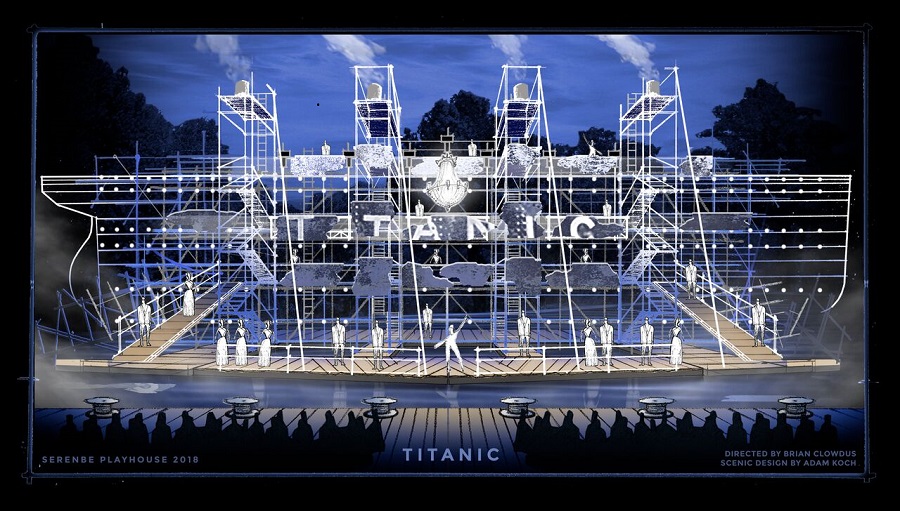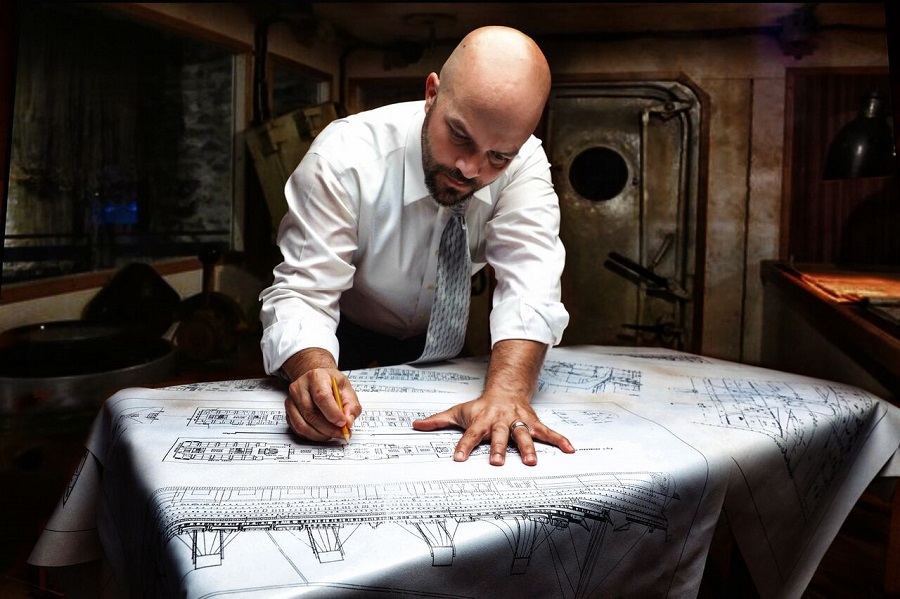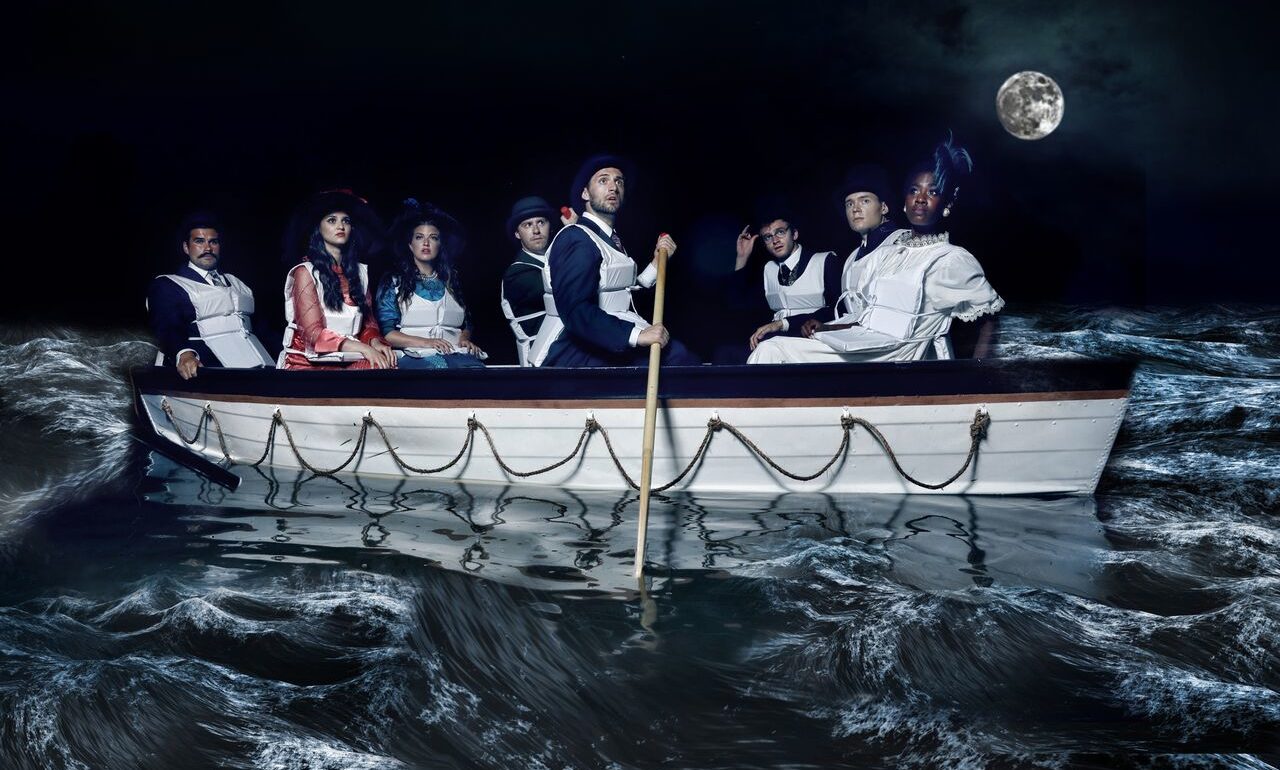Serenbe Playhouse isn’t afraid to think big when it comes to its site-specific, outdoor musicals: They built a fully operational carousel (and Ferris wheel) for Carousel and landed an actual helicopter for Miss Saigon.
But for its production of the musical Titanic, running July 11-Aug. 12, Serenbe takes “immersive theatre” to new heights, and depths. The production will sink a ship into the Inn Lake nightly—or, at least, portions of the three-story structure representing the titular luxury liner, as the cast of 40, mostly non-Equity actors find themselves in the water fighting for their characters’ lives.
“I had no idea how I was going to do it when I announced it,” admitted Brian Clowdus, founding executive/artistic director of the theatre company for the past nine years; he also directs Titanic. The company presents shows at various locations of this 40,000-acre, “new urbanism” community, located about 30 miles southwest of downtown Atlanta.
Titanic is by far the most elaborate production of the company’s “water-themed” season, which also includes The Little Mermaid, Peter Pan, and The Seagull. The company upped their regular budget for a show to $350,000, with $100,00 from the Home Depot Foundation. (The company, with an overall budget of $1.5 million, is a self-sustained operation presenting five productions a year.)

Building a structure that could float and sink in real time was a challenge for set designer Adam Koch. “I wanted to acknowledge Brian’s vision for the spectacle of it,” he said, “while at the same time respecting the intention of the creators because they didn’t envision it being on the actual water when they wrote it. But that also doesn’t mean we can’t do it.”
Clowdus and Koch started by looking at archival materials, especially photographs of the building of the ship. “There were these beautiful images of the Titanic being built, surrounded by scaffolding,” said the director, “and I thought, ‘Oh my God, it looks like a skeleton.'”
The structural set design that emerged for the show also echoes the original blueprint of the ship, which gave Clowdus his way into the story. The musical is a memory play, told through the eyes of its visionary shipbuilder, Thomas Andrews, who pulls out a blueprint of his “ship of dreams” at the start of the show.
“That is where our world lives, in the imagination of its creator, so I envisioned a kind of 3D blueprint of the Titanic in front of the audience,” said Clowdus. “I want it to feel as if we have entered into his mind and we are always aware of this original structure that was in his head.”

As Andrews recalls the ship’s doomed voyage, ghosts of the dead and survivors are summoned to a platform, representing the dock, directly in front of the audience of 400 situated on the banks of the lake. The characters are seen at first in the bedraggled nightwear of that fateful night. But then they change into elegant traveling attire as the musical flashes back to the initial boarding of the ship at its inaugural launch.
While this happens during the 20-minute opening number, which introduces the characters, the ship’s staff, and the three classes of passengers, who then help reconstruct pieces of the ship.
“I love exposing the bones of theatre,” said Clowdus, “so you’re going to see ropes, rigging and platforms being assembled. I wanted the characters telling the story to be in charge of the story as they construct and deconstruct their memory. It will be very hands-on. [The ship] does not just magically happen whole.”
Platforms will float in and come together; certain areas will rise up and lock in place; a chandelier emerges from the water (take that, Phantom of the Opera). In the second act after the ship hits the iceberg, certain parts of the structure will then be deconstructed, with some pieces titling precariously, like a window washer’s platform that has lost one of its riggings.

The basic set structure “is literally a house on stilts in the lake,” said Koch. Prior to four-and-a-half weeks of rehearsals, the depths of the man-made lake had to be mapped out, the water tested, and footings placed in the lake’s floor. The scaffolding pieces, Clowdus says, are rented from a licensed, insured construction company that installed the large structure.
“At a depth of only 10 feet, we didn’t have to go down as deep as we thought for the structure to be secure,” said Clowdus. “But that also means we have to be more creative about what we could sink by making pieces smaller and collapsible.”
Safety was also an issue. “After all, we’ll be putting 40 actors into a lake where they’re going to be submerged with all this machinery, so it needs to be as safe as possible,” he said. “When we did the casting we said, ‘If you can’t swim or are afraid of water, this is not the show for you.’”
Another challenge: “This is a Georgia lake with red clay on the bottom, so costuming-wise, we’re going to have muddy costumes at the end of the night. It could be quickly a hot mess if it’s not attended to well.”
When asked how he will follow up Titanic next year for the company’s 10th anniversary season, Clowdus just laughed. “Oh, Lord, I don’t know,” he said. “Our special effect next year will probably be a big Broadway star. I’ve learned that you cannot top yourself. You just have to reinvent yourself.”
Serenbe Playhouse’s production of Titanic, with a book by Peter Stone and music and lyrics by Maury Yeston. Direction by Brian Clowdus, music direction by Chris Brent Davis, choreography by Bubba Carr, production management by Joel Coady, scenic design by Adam Koch, costume design by Alan Yeong, lighting design by Kevin Frazier, sound design by Bobby Johnson, and prop design by Christopher Dills.




